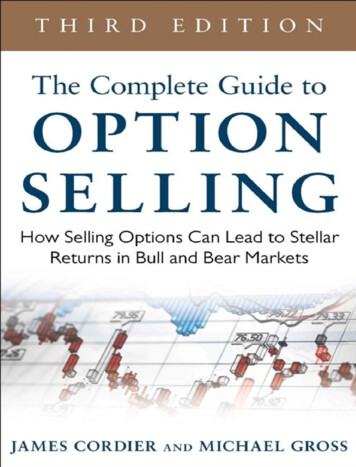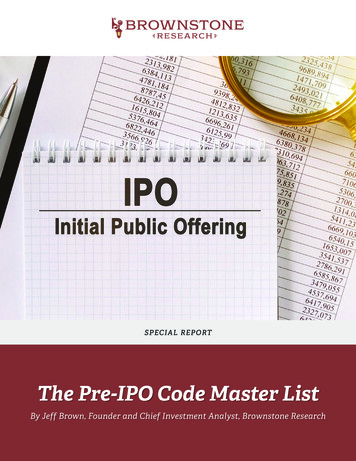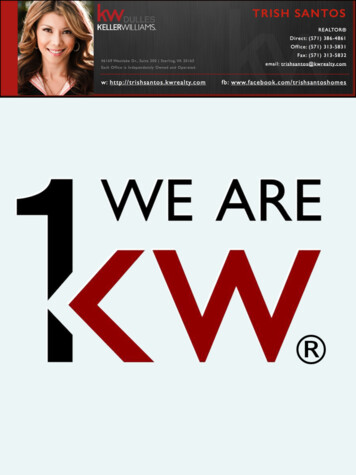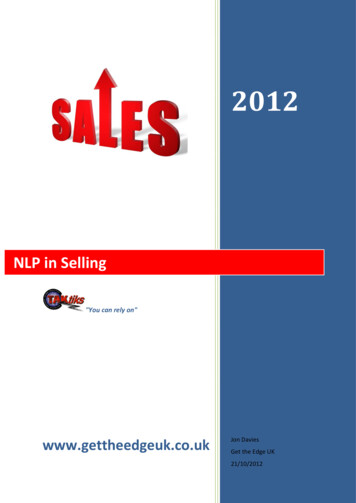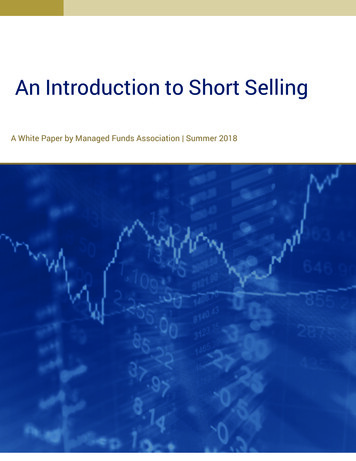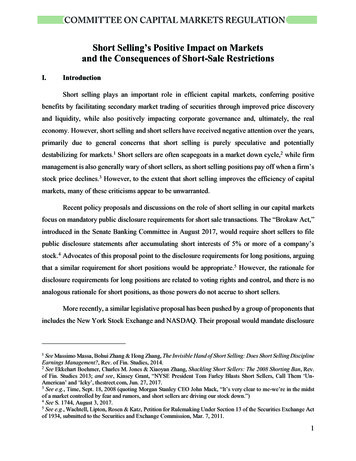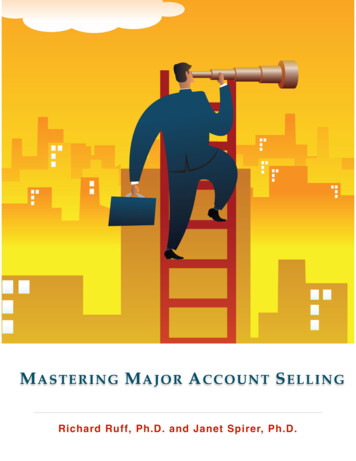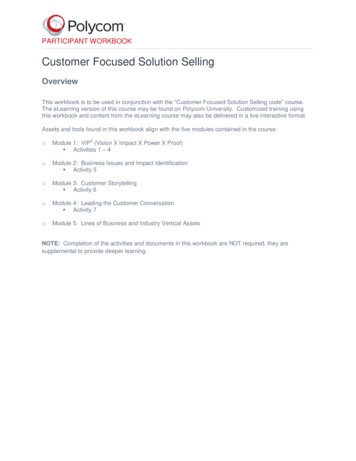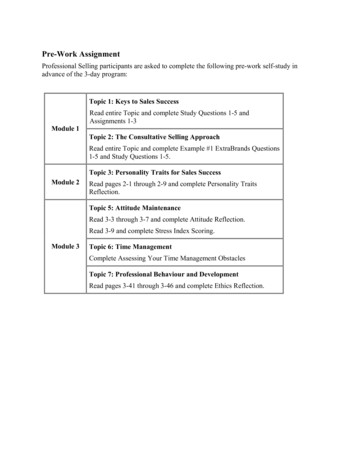
Transcription
Pre-Work AssignmentProfessional Selling participants are asked to complete the following pre-work self-study inadvance of the 3-day program:Topic 1: Keys to Sales SuccessModule 1Read entire Topic and complete Study Questions 1-5 andAssignments 1-3Topic 2: The Consultative Selling ApproachRead entire Topic and complete Example #1 ExtraBrands Questions1-5 and Study Questions 1-5.Topic 3: Personality Traits for Sales SuccessModule 2Read pages 2-1 through 2-9 and complete Personality TraitsReflection.Topic 5: Attitude MaintenanceRead 3-3 through 3-7 and complete Attitude Reflection.Read 3-9 and complete Stress Index Scoring.Module 3Topic 6: Time ManagementComplete Assessing Your Time Management ObstaclesTopic 7: Professional Behaviour and DevelopmentRead pages 3-41 through 3-46 and complete Ethics Reflection.
SKILLS FOR SALES SUCCESS SERIESPROFESSIONALSELLINGPARTICIPANT WORKBOOK
Skills for Sales Success Series – Professional Selling Canadian Professional Sales Association, 2009All rights reserved. No part of this publication may be produced, stored in a retrieval system, ortransmitted, in any form or by any means, without the prior written permission of the publisher.Written and Edited By: David J. Batchelor, AXCEL Performance SolutionsCover design: Katina Fyndikakis, CPSAPublished by:Canadian Professional Sales Association310 Front Street WestSuite 800Toronto, OntarioM5V 3B5Tel: (416) 408-2685 Toll-free: 1-888-267-2772Website: www.cpsa.comNational Library of Canada Cataloguing in PublicationProfessional Selling: Participant Workbook.(Skills For Sales Success Series)Previously published as: Skills For Sales Success / David J. Batchelor,Arthur H. Horn with H.L. Barry NortonISBN 1-895879-52-31. Selling. I. Canadian Professional Sales Association. II. Batchelor, David(David J.). Skills For Sales Success. III. Series.HF5438.25.B38 2004a 658.85Printed and bound in Canada04030201005 4 3 2 1C2004-902696-8
Module 1IntroductiontoProfessionalSellingProfessional Selling Canadian Professional Sales Association 1-1
Module 1: Introduction to Professional SellingModule Overview1.Introduction toProfessionalSelling2.UnderstandingYourself ategy5.6.ConsultativeSellingSecuring theBusinessModule ObjectivesAfter completing this module, you will be able to: Identify the five primary keys to sales success, whichprovide the structure for this program Understand and explain “Consultative” Selling and theConsultative Selling Process Describe the general principles of Value-Based Sellingand a Unique Value Proposition Explain how the Client Objectives Map relates to modernconsultative selling Describe ROI Selling and a Business Case approachModule ContentTopic 1: The Keys to Sales SuccessA Brief History of SalesConsultative Selling — DefinedThe Five Keys to Sales SuccessTopic 2: The Consultative Selling Approach Consultative Selling Principles1-2 Professional Selling Canadian Professional Sales Association
Topic 1: The Keys to Sales SuccessTopic 1: The Keys to Sales SuccessA Brief History of SalesThe first World’s Salesmanship Congress was held in 1916 in Detroit, and President WoodrowWilson was the keynote speaker.Many suggest that the first formal sales program was implemented at National Cash Register (laterknown as NCR) in Ohio, by John Henry Patterson.Some would argue that the art and science of selling began in the garden of Eden, and the prototypefor all salespeople is a nefarious serpent.Whereas evolutionists might claim that Homo Erectus was the first human to sell, via barter andtrade almost 1.5 million years ago.Regardless, the profession of modern selling in the 19th, 20th and 21st centuries has evolveddramatically. We’ve progressed from hucksters, to general stores, to canvassers, to travelingsalesmen (yes, mostly “men”), to the hard-sell salesperson, the highly relationship-orientedsalespeople that would “schmooze” customers for their business, to telemarketers and modern telesalespeople, and onwards to the more professional salesperson managing a “territory” on behalf ofa commercial organization.But in recent years there has been a profound evolutionary shift.Today, customers are far more educated and sophisticated, with access to more information thanthey had even ten years ago. And we all operate in an expanding global economy, facingintensified competition in almost every industry and sector. Therefore, historic approaches to salesare no longer effective.Until recently, we all believed that the fundamental role of sales representatives was to get peopleto buy your product or service.But today we finally realize that the single biggest key to sales success is to actually stop sellingaltogether. In today’s marketplace, people (at home and in business) don’t want to be “sold”. Infact, they resist it strongly. Instead, customers want to “buy” independently, or work with business“partners.”In order to succeed, we must break the historical push-pull dance that happens between salespeopleand customers (sales tries to convince, and customers try to resist).Consultative Selling — DefinedToday, professional selling requires a completely different approach than historically employed. Itinvolves shifting focus away from what you want (the sale) and instead becoming entirely focusedon the customer.Sales professionals must now adopt a truly value-based approach, whereby their mission is to addas much value as possible to the customer’s bottom-line.Naturally, the goal is to accomplish this by leveraging your products and services, and thusmaximizing revenue for your employer and commissions for you.Professional Selling Canadian Professional Sales Association 1-3
Module 1: Introduction to Professional SellingIn this program, we refer to this modern sales approach as “consultative selling.” However, it’salso known in some circles as value-based selling, needs-based selling, solution selling, ROIselling and other monikers.Consultative selling can be loosely defined as the process of diagnosing customer goalsand challenges, helping them prioritize their needs, and then tailoring your products andservices (solutions) to address those needs. It’s the process of being a “consultant” toyour customer and their business versus a “salesperson” trying to sell them something.By definition: Consult (kon-sult): to seek information or advice fromBut even consultative selling itself has evolved significantly since the term was coined in the1970’s by Linda Richardson.Today, consultative selling involves taking a more mathematical approach to satisfying customerneeds, where we focus on producing a financial Return-on-Investment (ROI) for the customer. Wemust create situations where the customer is not spending money with you, but instead investing ingreater profits than they would have otherwise realized.We’ll learn more about how to apply this ROI-based approach throughout this program.At this stage, we must simply be aware that this program asks you to turn upside down everythingyou may have learned about what it means to “sell.” If you can accomplish this, then you areready to proceed with the balance of the program!So, here we go!Five Keys to Sales SuccessVolumes of research and publication exist outlining what it takes to excel in sales. Just visit yourlocal bookstore for a sample.We could spend an entire day filling flipchart pages with the knowledge, experience, skills, andcharacteristics required to be a superstar sales professional.Luckily, all of these factors can be summarized into five core Keys to Sales Success:1.Product/Industry/Company Knowledge and Pride2.Sales Personality Traits3.Self-Management Skills4.Strategic Planning Skills5.Influential Communication Skills1-4 Professional Selling Canadian Professional Sales Association
Topic 1: The Keys to Sales SuccessThis Professional Selling program is structured around these five core keys to success. We willexamine them in detail throughout subsequent modules.Product/Industry/Company Knowledge and PrideSuperstar sales professionals tend to be significant experts in their industry, and highlyknowledgeable about their products, services and company. They are also typically very proud ofthe industry they work in, and the company and products they represent.Knowledge and pride – they’re equally important to sales success. A representative that is averitable expert on their industry and products/services, but isn’t very proud of them, likely won’tportray the confidence necessary to be supremely successful. Whereas, a representative that is veryproud of their industry, company, and products/services, but knows very little about them, won’tinspire confidence from customers, and results will suffer.Typical keys to sales success, such as product knowledge and insight into industry trends, fallwithin this category.In the end, this program can’t teach Product/Industry/Company Knowledge and Pride. They areyour responsibility. It’s up to you to seek out more training and development on yourproducts/services, industry, and company. And you must look inside yourself to harness your pridefor these same things.Sales Personality TraitsThis category concerns all of the intangible, internal keys to sales success that superstars tend topossess, such as: positive attitude, entrepreneurial spirit, empathy, honesty, drive and energy.There is significant research and evidence to support the role these traits play in sales success,and we will explore them in more detail in Module 2.Self-Management SkillsIt can be argued that these skills are critical to success in life, let alone sales. Regardless,success as a modern-day sales professional is at least partly dependent on your ability to manageyourself. You must manage your time effectively, cope with stress, and maintain a positiveattitude in the face of adversity and negativity.These topics are covered in more detail in Module 3.Strategic Planning SkillsSuperstar salespeople tend to be good strategic planners. They build strong territory and accountplans. They conduct market segmentation, competitive analysis, and they understand theirrelative Strengths, Weaknesses, Opportunities and Threats (SWOT) within the marketplace andindividual accounts.More importantly, they tend to build step-by-step action plans that will enable them to achievetheir clearly defined goals.This Key to Sales Success is covered in Module 4.Professional Selling Canadian Professional Sales Association 1-5
Module 1: Introduction to Professional SellingInfluential Communication SkillsThis is the category we most often think of when it comes to selling. It represents the skills youuse when you’re face-to-face or over the phone with customers. Skills like question asking,objection handling, listening, presenting, building rapport, negotiating and closing fall into thiscategory, among many others.This Key to Sales Success will be covered in significant detail, especially in Modules 5 and 6.Summary1. The sales profession has evolved significantly over the past century:9 From hucksters and general stores;9 To door-to-door and traveling salesmen;9 To the hard-sell salesperson and aggressive telemarketers;9 To more relationship-oriented business sales people;9 And finally, to today, where we must now adopt a highly consultative,customer-centric approach.2. Consultative selling can be loosely defined as the process of diagnosingcustomer goals and challenges, helping them prioritize their needs, and thentailoring your products and services (solutions) to address those needs. It’s theprocess of being a “consultant” to your customer and their business versus a“salesperson” trying to sell them something.3. The five core Keys to Sales Success are:I. Product/Industry/Company Knowledge and PrideII. Sales Personality Traits (Module 2)III. Self-Management Skills (Module 3)IV. Strategic Planning Skills (Module 4)V. Influential Communication Skills (Modules 5 & 6)4. The first Key to Sales Success (Product/Industry/Company Knowledge and Pride)is entirely your responsibility. It cannot be taught in a program like ProfessionalSelling.1-6 Professional Selling Canadian Professional Sales Association
Topic 1: The Keys to Sales SuccessStudy Questions1. Characterize how the sales profession has evolved from its inception to today:2. What are the core Keys to Sales Success in today’s marketplace?1.2.3.4.5.3. In your own words, define “consultative selling” and describe how it’s different fromhistorical sales approaches.Professional Selling Canadian Professional Sales Association 1-7
Module 1: Introduction to Professional Selling4. Explain why it is so important to take a more consultative approach to sales today?5. In this chapter we discussed the importance of possessing significantproduct/industry/company knowledge, as well as a great deal of pride for those same things.(a) What would happen if a sales professional had significant product/industry/companyknowledge, but little pride in those same things? Specifically how would it impact salesresults and why?(b) What would happen if a sales professional was very proud of his or her products,industry, and company, but was not a very deep expert in these areas? Specifically howwould it impact sales results and why?1-8 Professional Selling Canadian Professional Sales Association
Topic 1: The Keys to Sales SuccessAssignments1. Recognizing that you have just begun this program, using the chart below, assess your ownknowledge, skills, and abilities on the five core Keys to Sales Success. Be introspective andhonest. How would your manager score you on each item? What about your colleagues?How about your customers?LowHigh1. Product/Industry/Company Knowledge and PrideProduct/Industry/Company knowledge and expertise123456Pride in your Industry, Products/Services, and Company1234562. Sales Personality Traits1234563. Self-Management Skills1234564. Strategic Planning Skills1234565. Influential Communication Skills123456(a) List the items below on which you scored yourself less than 4 on the scales above. Whatdoes this mean to you as a sales professional?Professional Selling Canadian Professional Sales Association 1-9
Module 1: Introduction to Professional Selling2. Using the space below, outline your personal development plan to increase yourProduct/Industry/Company Knowledge and Pride, recognizing that it is one of the core Keys toSales Success.3. Based on your self-assessment in Assignment #1, and referring to the Table of Contents for thisprogram, list the specific modules and topics that will be very important for your development asa sales professional.1 - 10 Professional Selling Canadian Professional Sales Association
Topic 2: The Consultative Selling ApproachTopic 2: The Consultative Selling ApproachConsultative Selling PrinciplesAs discussed in the previous topic, today’s most successful professional sales representatives use avery similar approach to secure and keep customers. It’s called consultative selling.We know from research, as well as the accumulated experience of thousands of successfulsalespeople, that those who use consultative selling techniques have a much higher success ratethan those who don’t.Recently, Sales and Marketing Management magazine reported that one of their extensive surveysshowed that young women are out-selling men by a very wide margin. Researchers found thatmost females—new to selling—did not assume that personality alone would lead to success. Infact, they tended to recognize that they knew very little about professional selling, and thereforetook courses and applied what they had learned.What they learned is a methodology that recognizes customers don’t want to be “sold”—they want“partners.” In fact, today’s customers are demanding a consultative selling approach.Ask Don’t Tell – Investigate Don’t SellIn order to adopt a more customer-centric consultative approach to sales, we must break afundamental paradigm. Most people believe that the key to “selling” is to convince customers tobuy your product or service, by telling the customer about its virtues. This has been ingrained in ussince childhood, based on experiences with retailers, telemarketers, and other salespeople.Consultative selling forces us to forget this key assumption, and instead, adopt a more inquisitiveapproach. Recall, the definition of consultative selling is to thoroughly diagnose customers’ goalsand challenges, collaborate on their resulting priorities, and only then start to determine how yourproducts and services can help them reach their goals.This approach is very similar to the consultative process employed by other professionals.Consider the examples on the next page.The Family Physician Imagine that you need to go to the doctor for a minor ailment. What do you do? You call for anappointment. Just like in sales, our meetings with physicians are typically scheduled appointments.When you arrive at your appointment, here’s what happens:9 You introduce yourself to the receptionist/nurse and she asks for and records information—at leastyour name, address, and health card number. In other words, she opens a “customer record” andestablishes how the bill is going to be paid. She then asks you to wait.9 You wait.9 Eventually, she shows you into an examination room.9 You wait.Professional Selling Canadian Professional Sales Association 1-11
Module 1: Introduction to Professional Selling9 The doctor comes in and introduces herself/himself and visits a little (spends some time catching upor getting to know you for the first time).9 The doctor asks open-ended questions, such as “How are you?” or “Please tell me what’s wrong.”9 Depending on your answers, she/he continues to ask for more information: “Please clarify that, Idon’t quite understand,” or “Please tell me more.”9 After finding out about what ails you, she/he gives you a specific examination (if you have specifiedit is your left hand that’s giving you grief, she/he isn’t likely to examine your right foot). During thisstage of the visit more questions are asked: “How does this feel?” “Does it hurt here?” “Do this.How does that feel?” etc.9 Once the doctor gets as much information as possible from you, the patient, she/he assimilates it,applies knowledge and deductive reasoning, and decides on solutions to the problem (gives thediagnosis and recommends treatment alternatives). Please note: a doctor seldom recommends justone course of action. Usually she/he will say something like “We can look after this by ” or “Irecommend we try this first.”9 At this point the doctor outlines an action plan that includes setting a follow-up appointment.9 You leave, and on the way out the nurse/receptionist sets up your next appointment.9 When you go to the next appointment you experience the same step-by-step process with somevariation in the words.The Lawyer, Accountant, Architect, Engineer If you go to a lawyer, chartered accountant, architect, consulting engineer, professional businessconsultant, undertaker, or other professional, you’ll discover they all go through a similar process.They do so for the following reasons:1. It places the customer first, at the centre of the process, not their solutions—which is preciselywhat all of us demand today as customers.2. They have been trained in the use of a step-by-step process that many before them havediscovered works best, and they realize it’s not necessary to reinvent the wheel.3. It is a logical process that helps ensure they don’t leave anything out.4. It uses modern psychological compliance principles such as rapport, authority, reciprocity,reason, consistency, and social evidence, and therefore gains patient/client compliance and as aresult patients/clients take their advice.5. It increases their efficiency by guiding them in a way that saves precious time.6. It saves payouts on malpractice litigation. (Some years ago, a Florida doctor missed a criticalstep in the procedure and amputated a man’s left leg instead of his right.)1 - 12 Professional Selling Canadian Professional Sales Association
Topic 2: The Consultative Selling ApproachClient Objectives MapConsultative selling requires us to put our own objectives in the background. We must focus on thecustomer’s goals and challenges, help them prioritize their needs, and only then begin considering theunique solutions you can offer. Just like a doctor, most of the emphasis is on the diagnosis, versusthe prescription.Key BusinessResults andMeasuresNeeds andObjectivesBusinessIssuesEXHIBIT 1: The Client Objectives MapThe illustration above summarizes the sequential issues we must cover in our investigations withcustomers: goals, challenges, and resulting needs. Like the physician’s diagnosis, the key is to gaina very thorough understanding of the current situation, so that you can then collaborate on solutionsto help them reach their goals.In most cases, the customer’s objectives are focused on financial performance (see Return-onInvestment below). However, in some cases, customers are equally concerned with other efficiencyor effectiveness measures such as quality, time savings, or employee/customer satisfaction.We’ll cover this topic in more detail in Module 5.Return-on-Investment (ROI)Today’s customers are much more sophisticated than ever before. More importantly, organizationstoday are being managed much more closely based on their profit and loss statements. In otherwords, many business decisions these days are based strictly on the impact to the bottom-line.Therefore, sales professionals today must ensure that everything they do is focused on helping thecustomer improve their bottom-line.Colloquially speaking, we want to create a situation where the customer needs to incur noexpenses instead, anything they invest with you is only designed to produce a larger return to theirbottom-line. We call this approach ROI Selling and it’s a core element of consultative selling.Practically speaking, our goal is to show the customer how our solutions can either help them cutcosts or grow revenue—since these are the only two things that can improve the bottom-line.We’ll cover this topic in more detail in Modules 5 and 6.Professional Selling Canadian Professional Sales Association 1-13
Module 1: Introduction to Professional SellingBusiness CasesGenerally speaking, professional selling is like being a consultant to your client’s organization. Andconsultants typically follow the same process. They collaborate with clients to:1) Define the current state2) Determine the ideal future state3) Prescribe solutions to close the gap between 1) and 2).CurrentGAPIdealFutureEXHIBIT 2: The Gap AnalysisWe call this process a “gap analysis,” and it works in conjunction with the Client Objectives Map,and ROI Selling.When it comes time to present your solutions to customers, you must do it in a way that lays out allof the information in a logical argument for the customer. We need to make the customer’s decisionprocess as easy as possible for them.Remember, customers are paid to make smart business decisions. So, we must outline our proposalsin a format that helps them do just that.We can use the Gap Analysis model (Exhibit 2) to structure a strong business case for customers.Our proposals can be structured as:Background – The current stateObjectives – The ideal future stateProposed Solution – What will close the gap for the customerExpected Benefits – ROI analysis and other benefitsProposed Action Plan – Next steps and timelinesAs modern sales professionals, we must always ensure our efforts are uncovering the informationneeded to complete each section of a business case proposal. This will also help guarantee that weare very customer-centric and consultative in our approach.We will explore this type of business case methodology further in Modules 5 and 6.1 - 14 Professional Selling Canadian Professional Sales Association
Topic 2: The Consultative Selling ApproachExample #1: The ExtraBrands StoryThe following is a true story, but the names of the principal players and the companies involved havebeen changed.ExtraBrands is a very large international company in the food business and operates independentlyin Canada. It produces and markets several well-known packaged food products, many of which areeither first or second in market share. It also manufactures products that are sold to the foodservice/hospitality industry.The new regional manager in Ontario, Harold Lyle, analyzed the company’s sales record anddiscovered that while roasted coffee sales to the consumer market were second in market share, salesto the food service industry ranked about seventh in his region. As a result of this analysis, he madesome sales calls with a number of sales reps and determined that the reason sales were so poor wasthat the reps didn’t know how to sell. What they did was a “data dump.” That is, they listed all theattributes of the product, without relating those attributes back to the customer’s needs.Lyle called two other regional sales managers, John Campbell and Jack Tucker, into his office andthe conversation went something like this:Lyle: Gentlemen, we don’t know how to sell coffee. Last year we sold a little over 300,000 poundsin a market that is growing at an incredible rate. If we were only third in market share, our saleswould be about three million. What are your recommendations?Campbell: What do you mean we don’t know how to sell?Lyle: That’s what the statistics show. All I’ve observed is sales people sounding like a productbrochure, and that’s not getting many new customers.Tucker: How should coffee be sold?Lyle: Well, I don’t think a restaurant owner who has just opened a business, or one who’s beenaround a while, is impressed with the fact we’ve been in business for seventy-five years, or thatwe’re the second biggest food company in the world, or that we can supply his coffee in threeblends, two roasts, and five different package sizes, or that our truck stops every week.Campbell: How should we sell then?Lyle: I don’t know, but we’ve got to find out! John, who are the big potential customers in yourarea?A discussion followed and it was determined there were several potential customers who boughtaround 1,000,000 pounds per year. One of these was NIB Catering, a coast-to-coast enterprise withfive relatively autonomous regional managers, and a general manager, Bruce Bell, in Toronto. NIBoperated 250 industrial commissaries and/or cafeterias.Professional Selling Canadian Professional Sales Association 1-15
Module 1: Introduction to Professional SellingLyle: John, call Bruce Bell and ask for thirty minutes of his time for you and me. Tell him I want tomeet him and ask his advice.Bruce Bell was a man in his early sixties, very polite, extremely well dressed, very distinguishedlooking, and soft-spoken. He showed the two salespeople to chairs in his comfortable, if not plush,office.Bell: How can I help you gentlemen?Lyle: Mr. Bell, my name is Harold Lyle. I’m the new regional manager for ExtraBrands.Bell: I saw the announcement of your appointment in the Globe and Mail. Congratulations.A few minutes of small talk, including a brief discussion about the rapid growth of the food serviceindustry, NIB’s similar growth pattern, and ExtraBrands’ success in general, ensued, at the end ofwhich Lyle got down to business.Lyle: We appreciate your setting aside time for us. Bruce, we’ve got a problem. We don’t knowhow to sell coffee and I’ve come today to ask for your advice. Perhaps I could start by asking youthis question: If you had a magic wand and could conjure up the perfect coffee supplier, what wouldyou expect that supplier to do for you?Bell: That’s an interesting question. I’ve never been asked one like it before. Well . you know, acup of coffee is the last thing most of our customers taste just before leaving one of our cafeterias. Itwould be a really big accomplishment if the vast majority left with a good taste in their mouths!Now, most customers, I’m afraid, do not. In fact, we get many complaints about the inconsistencyof quality from coast to coast. So I guess my first wish would be to have suppliers who would workwith us to establish a taste that will satisfy the majority of our customers and to develop a way toconsistently produce that taste.Lyle: Please explain how you work with your suppliers now.Bell: Each region is responsible for purchasing locally. Currently we buy from three and sometimesfour coffee companies. The product is treated much like a commodity. That is to say, our buyers getquotes on the various sizes used in each facility and make a decision. Some regional managerspersonally approve the product and supplier, and others delegate those decisions to unit managers.The delivery is generally once a week, but in high-volume units it can be more frequent.Lyle: What happens once the coffee is received? I mean, how is it stored, brewed, served? Arethere standards that are applied to these activities?Bell: We do not have a centralized food purchasing procedure. Each region determines howproducts are stored, and how finished goods are produced and served. Production people tend to bevery opinionated as to which methods work best, so we have let them do it their own way. Forexample, some units store coffee in the refrigerator while others place it on shelves in the regularstoreroom. Some believe their way of brewing is the best, so we have various methods and types ofequipment being used. Depending on the type of environment in which the cafeteria is located, acup of coffee might be served in a paper, foam, or china cup.1 - 16 Professional Selling Canadian Professional Sales Association
Topic 2: The Consultative Selling ApproachLyle: Bruce, if your goal is to have customers leave ev
Module 1: Introduction to Professional Selling In this program, we refer to this modern sales approach as “consultative selling.” However, it’s also known in some circles as value-based selling, needs-based selling, solution selling
